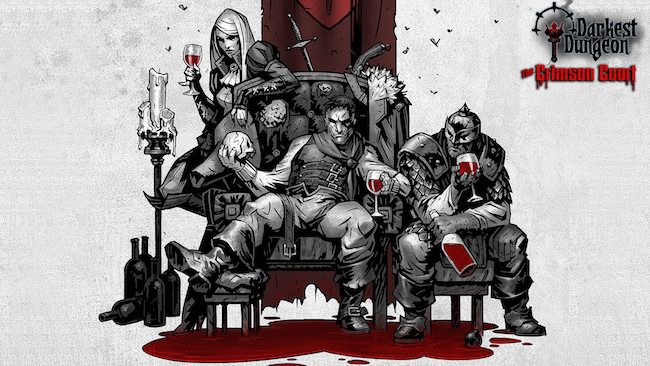
Darkest Dungeon is such an excellent game in so many ways, and I’ve spent a disgusting amount of time with it despite the way it punishes me. Like a battered lover, the only thing keeping me from calling the authorities is my belief that the things Darkest Dungeon does are out of love. Terrible, misguided, brutal love. After trying to go back to my old save file and getting several of my high-level heroes murdered, I decided to go back to basics and start over from scratch. Keep in mind while reading this article that, for the purposes of this new playthrough with Crimson Court, I spent most of my time playing on easy mode. While enjoyable for its sadistic difficulty, I can’t really peg whether it should be considered content to be played parallel to the base-game, or end-game content. Both have merit but are also fraught with problems, and so I’m left feeling somewhat ambivalent about this expansion.
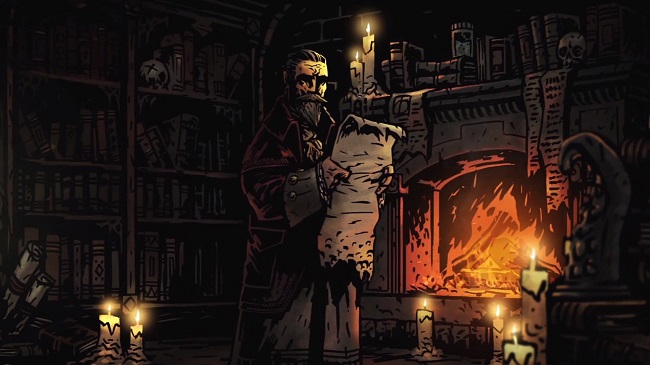
“You remember our venerable house, opulent and imperial, waiting for the slightest lapse in guard to drop you, then kick you while you’re down.”
I’ve reviewed Darkest Dungeon before (you can read that over here), so this is only going to be about the Crimson Court DLC. Besides those that have come with Crimson Court, the game has seen some updates that have changed things, added stuff, or balanced mechanics. None of this should be taken to mean that the game is any easier than it was, or that it can’t be called ball-breakingly unfair at any given moment. Darkest Dungeon is still very much both of these things, it’s just found new and exciting ways to embody them. This is largely through the use of the Crimson Curse or, as I’ve come to call it, “Sweet Jesus, not this shit again.” Really, Crimson Court is for players who believed the game wasn’t hard enough already.
As much as I’d like to say that the Crimson Court should be played alongside the rest of the campaign, as it’s largely designed that way, it works better as end-game content though that also comes with its own problems. Things are kicked off by the opening of a new area outside of the main four, that being the titular Court itself, which is a sort of manor garden if it were tended to by Vincent Price. Housed within are the aristocrats that enjoyed a hedonistic life under your ancestor’s rule of the land, now horrifically mutated and craving blood. This first area is a Lv.1 dungeon, meaning your high-level heroes won’t even touch the mission. If you’ve got a roster full of champions then you’ll need to hire some newbies, and they’re going to have a bad time.

I mean, you’d think the Leper would be used to living with disease but I don’t think he’s comfortable around the adventurers foaming at the mouth for blood.
It’s at this juncture that the dissonance between parallel-play and end-game content becomes apparent, as dealing with the Court is hard as hell. Enemies in the court don’t scale with your level, they start somewhere around “Hero Devourer,” and stay there. An unavoidable mini-boss for the first Court mission will absolutely wreck your low-level party. “Mini-boss” is also a generous description, as it could easily compare to some of the higher level bosses from the other areas, it’s just not as powerful as the bosses you’ll face later on. Assuming you survive the assault, your reward is unleashing the Curse upon everything surrounding it before having the gates to the Court closed off to you.
After the first Court mission, several things happen. Firstly, infected enemies start appearing in the other areas making it that much easier to be infected by the Curse. Each area also starts an infection level and, when it hits max, will spawn a Gatekeeper. Killing Gatekeepers is the only way to get access to the Court after the first mission, prying an “invitation” from its corpse. You’ll also need to start hoarding “The Blood,” small phials of exactly what you’d expect, that sate the bloodlust of any infected heroes. Briefly, at least. Lastly, if you have at least two infected heroes in your party, there’s a good chance that you’ll run into the Fanatic. The Fanatic is a wondering boss in infected areas outside of the Court and wants to purge the Crimson Curse. With fire. He’s going to burn you to death, is what I’m saying, and he is a bastard to kill.

“FINE! KICK ME OUT! I’LL JUST GO PARTY WITH THE SIREN AND THE HAG! AND THIS GUY – SEEMS PRETTY COOL… Wait.”
Contracting the Crimson Curse is as simple as taking a hit from an enemy carrying the infection, which includes just about any monster inside the Crimson Court. Once you have the curse, it’s incredibly easy to spread around to your other heroes. If you put them in the same treatment or stress relief area in the estate, there’s a high probability that the disease will be passed onto another hero in that same area. When adventuring it inflicts constant debuffs, unless the infected heroes have fed on The Blood, which grants buffs at the cost of them constantly screeching about how hungry they are for more. This, in turn, increases the stress of everyone in the team, who are likely also infected and doing the same damn thing. If inflicted and without The Blood for too long, they’ll literally waste away (but not before attacking your own team members, possibly infecting them, as well.)
Quests into the Court now become “Epic Quests,” allowing your progress to be saved after leaving, so that you’ll re-enter the dungeon on the same tile you finished on, with your exploration thus far kept intact. This is a good thing because the Court is absolutely massive in its proportions, a huge maze with locked doors and their heavily guarded, colour-corresponding keys. Getting through just a small part of it can feel like you’ve taken a high-level run through the Darkest Dungeon itself, with a party of champion level heroes no less. The Blood drops like candy in this place, as well, but not so often in the other areas, which makes regular trips to the Court a necessity.

“Uh, guys, have we been going around in circles? I swear I’ve seen that pulsing cocoon before and BOY I JUST CAN’T WAIT TO DRINK THAT SCARLET JUICE, REEEEEEEEEE!”
So, to sum up, you need invitations, which can only be picked up from Gatekeepers. Gatekeepers only appear after the infection level hits max, which increases with every dungeon run. You’ll be doing plenty of dungeon runs anyway, either to maintain upkeep or continue upgrading your Estate. The trips into the Court themselves are quite short and incredibly perilous, but essential because it’s the best way to get The Blood. The Districts can greatly alleviate the effects of the Curse but are almost prohibitively expensive if you’re still trying to build your Estate. And this is all beside the base-game content that you may or may not have accomplished already. Either way, experienced as a new playthrough add-on, or a veteran adventurer looking for end-game content, the whole thing can become either a long, drawn out campaign or a massive grind for materials.
Darkest Dungeon is at its best when every excursion feels like it counts, when trundling your heroes out into the countryside feels as though you’re very likely sending them to their deaths. Losses feel like major blows to your agenda, victories feel like you’ve conquered something insurmountable. It all hinges on the fact that you’re basically living mission to mission, adding the kind of tension to gameplay that the game’s atmosphere demands. If you turn it into a grind, then that tension disappears and everything becomes routine. If it suddenly becomes so hard and soul crushing that jamming the bones of your childhood pet into your eye sockets seems like a good time, by comparison, the game stops being fun. I mean, I like Darkest Dungeon for being exceedingly hard but I also like to win sometimes. It’s not irreparable but, in its current state, The Crimson Court hasn’t found a good balance between these two extremes to really fit into the rest of the game.
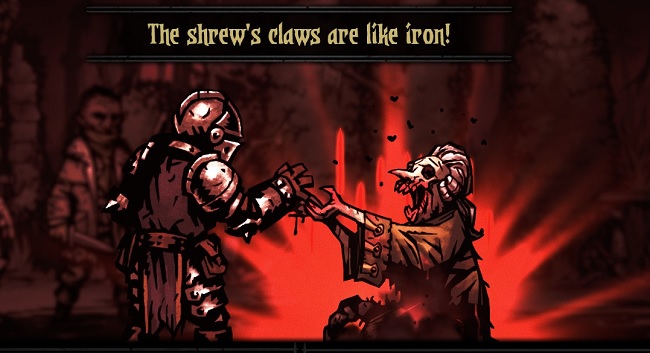
“Boy, I’mma cut you so bad, and git all up in dem wounds wif mah TEEFS!”
This isn’t to say that developers Red Hook didn’t try to keep to the spirit of things when developing Crimson Court. Everything is still delightfully morbid in its presentation and function. The new faction of enemies in the Court are disgustingly fantastic, a horrific mish-mash of humanoids, insects, and crustaceans. Seriously, their bulbous, black lobster eyes creep me the hell out. The Court has some well-designed visuals, portraying an abandoned garden park that’s slowly morphing into a decaying swamp. The corridors are littered with discarded trollies of rotting food, abandoned wine crates of questionable content, and… Other things best left unmentioned.
The Flagellant, another Crimson Court addition, is probably my favourite character class; certainly better than the Antiquarian, whose only mention in this article will be that one. This dude whips and beats on himself to damage enemies, and can take blight or bleeding status effects from others onto himself, while benefiting from doing so. He can heal both himself and another character with the same ability, can cast a heal-over-time on another character, or if he’s at low health himself can claw back a huge amount by beating on the enemy. Aside from fitting brilliantly into the gothic horror theme, the Flagellant can absolutely kick everything in the dick, even if it doesn’t have a dick. He’ll give it one, then kick it there. I also figured out that you could name your heroes, and so my chief Flagellant was known thusly:
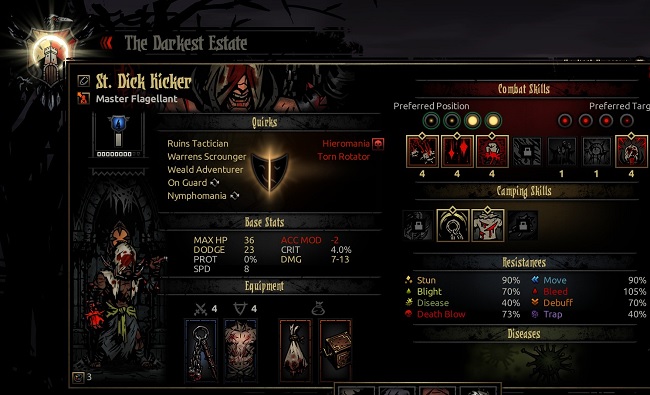
St. Dick Kicker, patron Saint of the bow-legged wheeze and squeeze.
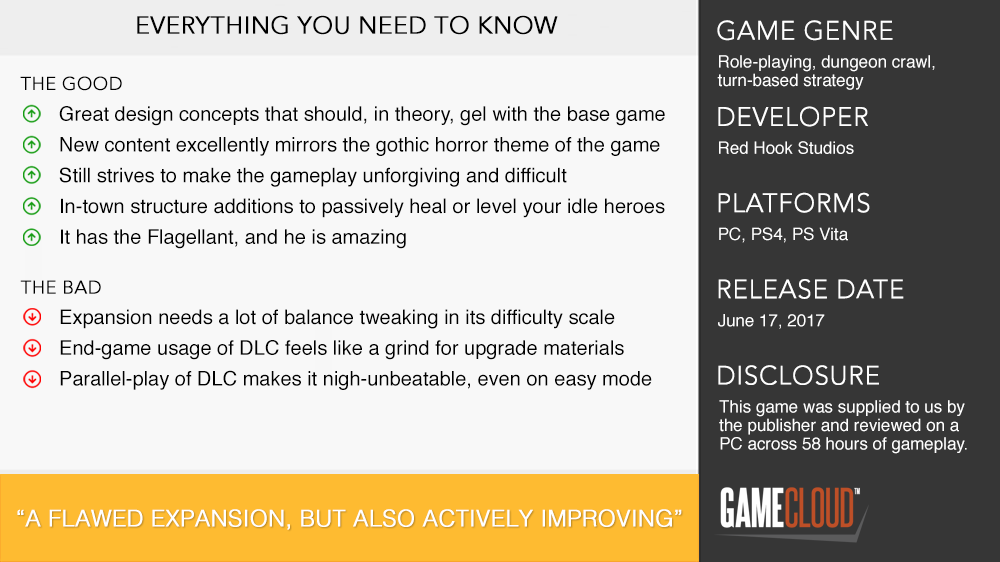
If you’re the kind of person that complains about games being hard, or unfair in their mechanics, then Darkest Dungeon probably isn’t for you. It’s in that same vein that, if you played the original game and thought that it was too difficult, The Crimson Court expansion probably isn’t for you either. In combination with the base game, it can make progression exceedingly hard, if not outright impossible for some. As end-game content, the process of completing it can become a grind, which takes away from the tension Darkest Dungeon carries so well with its initial design. The expansion isn’t all bad, with the additional content and mechanics themselves being interesting and unique additions to the game. Red Hook is actively updating the expansion content based on player feedback, and have been since its release. Hopefully, in the future, it will be much more balanced and live up to its potential. Right now, however, it’s just kind of a slog through Darkest Dungeon’s oppressive love taps.











